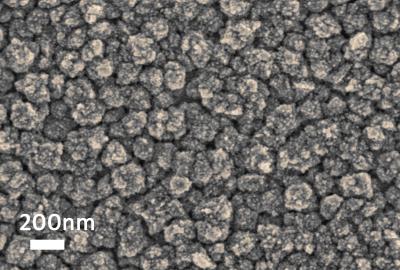

A metal nanosponge is shown under the microscope.
Credit: Jordi Sort/UAB
In 2007, French scientists observed that when the magnetic materials are put into ultra-thin layers and voltage is applied, the amount of current and energy needed to point the magnetic domains was reduced by 4%. However, this slight reduction was not significant enough to be applied to devices.
A research team directed by Jordi Sort, ICREA researcher and lecturer of the Department of Physics at the Universitat Autònoma de Barcelona, with the collaboration of the Catalan Institute for Nanoscience and Nanotechnology (ICN2), has searched for a solution based on the magnetic properties of a new nanoporous material which could increase this surface.
The new material, which is featured this week in the Advanced Functional Materials journal, consists in nanoporous copper and nickel alloy films, organised in a way that the interior forms surfaces and holes similar to that of the inside of a sponge, but with a separation between pores of only 5 or 10 nanometres. In other words, the walls of the pores contain enough room for only a few dozen atoms.
“There are many researchers applying nanoporous materials to improve physical-chemical processes, such as in the development of new sensors, but we studied what these materials could provide to electromagnetism”, Jordi Sort explains.
“The nanopores found on the inside of nanoporous materials offer a great amount of surface. With this vast surface concentrated in a very small space we can apply the voltage of a battery and enormously reduce the energy needed to orientate the magnetic domains and record data. This represents a new paradigm in the energy saving of computers and in computing and handling magnetic data in general”, says Jordi Sort.
UAB researchers have built the first prototypes of nanoporous magnetic memories based on copper and nickel alloys (CuNi) and have reached very satisfactory results, with a reduction of 35% in magnetic coercivity, a magnitude related to the energy consumption needed to reorientate the magnetic domains and record data.
In these first prototypes, researchers applied the voltage using liquid electrolytes, but are now working on solid materials which could help implement the devices in the market. According to Jordi Sort, “Implementing this material into the memories of computers and mobile devices can offer many advantages, mainly in direct energy saving for computers and considerable increase in the autonomy of mobile devices”.
The development of new nanoelectronic devices with improved energy efficiency is one of the strategic lines included in the European Union's Horizon 2020 programme. According to some estimations, if electric current is completely substituted by voltage in data processing systems, energy costs can be reduced by a factor of 1/500. In fact, computer servers of large companies such as Google and Facebook are located underwater, or in Nordic countries in which temperatures are very low, with the aim of reducing heating and energy consumption.
###
Participating in the research, which corresponds to the first results obtained thanks to the ERC-Consolidator Grant received by Professor Jordi Sort for his project SPIN-PORICS (Merging nanoporous materials with energy-efficient spintronics), with a total funding of €1.8M, were: Alberto Quintana, Dr Jin Zhang, Dr Eloy Isarain-Chávez, Dr Enric Menéndez, Prof Maria Dolors Baró, Dr Miguel Guerrero and Dr Eva Pellicer from the UAB Department of Physics, who together with Prof Josep Nogués from the Catalan Institute for Nanoscience and Nanotechnology (Severo Ochoa Excellence Center), developed the nanoporous material and conducted the magnetic measures. Other authors of the study are: Dr Ramón Cuadrado, Dr Roberto Robles and Prof Pablo Ordejón from the ICN2, who developed the theoretical calculations needed to understand what happens inside the material; Dr Bradley Nelson from ETH Zurich, with whom the work on the CuNi alloy began; and Professor C. M. Müller from the University of Barcelona, who provided the electrochemical measures of the laboratory material of the Department of Materials Science and Physical Chemistry.












